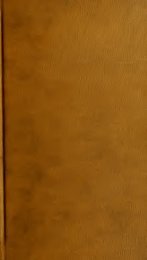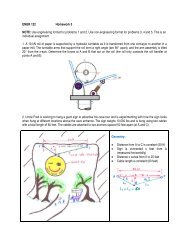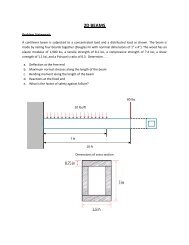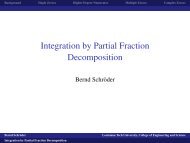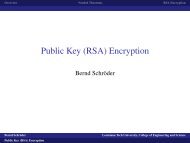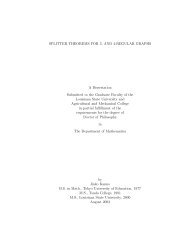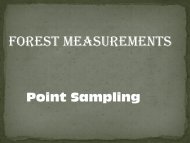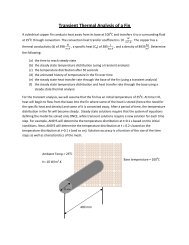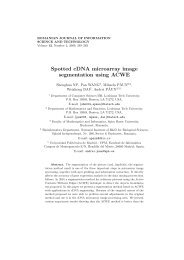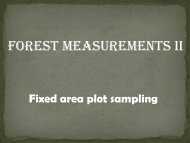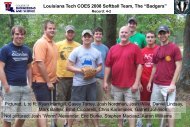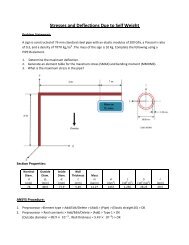On Generating Pathological Orthomodular Structures
On Generating Pathological Orthomodular Structures
On Generating Pathological Orthomodular Structures
You also want an ePaper? Increase the reach of your titles
YUMPU automatically turns print PDFs into web optimized ePapers that Google loves.
ON GENERATING PATHOLOGICAL ORTHOMODULAR STRUCTURES<br />
by<br />
R. J. Greechie<br />
Technical Report No. 13<br />
April 1970
<strong>On</strong> CcnCl."nUng l'.::Jtllu!t'uicnl Orlhc:r:(lc!ulnr StructlJrcs<br />
by<br />
R. J. Crcccbie<br />
lntrextuction. By an orthnmodulDr structure we n:e.an an ortholnodul.:lr<br />
poset or nO. ortbo::loclular lattice. Viewecl as a generalization of the prototypical<br />
orthomodular structures generatcd by conternjJor:lry functional a:lalysis<br />
(e.g., the projection lattice of a von Reu~:lnn alg~bra), !!! of the structu=es<br />
~itecl'in<br />
this pnpcr are indeed patholozical. Viewed as a general setting for<br />
recent work on em~irical<br />
lotic [16], ~ of the structures cited here :lre<br />
still patholozical. But viewed as structures of a co=binatorial inter~st,<br />
the .examples presented indicate that the study of "orthc:nodularity" ,in<br />
structures of "small" cilrdinality may very ...ocll yield insight into as yet<br />
unformulated concepts pertinent'to the theory. Fro:a this pOint of vie''': we<br />
I<br />
consider these structures to be anything but pathological.<br />
Essentially we depict an orthomodular structure as a union of 8iopl~r<br />
such structures, usually Boolean lattices, and investiS3te ho\..1 the sim~ler<br />
structures arc intertt-1ined.<br />
From this point of view the Boolean liltticcs<br />
are trivial and the projection lattices quite complicated.<br />
to exhibit so;nc simpl~<br />
.<br />
Thus our goal is<br />
but non-trivinl orthomoclul:lr structures. We will<br />
selcct OUi'. examples to be of maxbnal interect to quant\!l:l logicians•<br />
..<br />
At«llll.<br />
,
By n e1"II\o'" [5J we II1C~lI :l co!,y of 2~ (0,1] t sec }'if,un~ I.<br />
Fif,Ul' to Obtnin nu Ol"thomodlllar Por.('t.<br />
~finit 1on: R~c:ll1 tho3t a suh-orthomodlllar po~ct R of an orthomodul:tr<br />
PO!#~t Q 1:; a n<strong>On</strong>-eT:lJlty nub:.et of Q wl~ich satis!ies the fo110win& conditions<br />
{or nIl X, y c R:<br />
(1) x' ( It,<br />
(H) )( :::: y in n If nlhl ~nly If X :": Y 1n Q,<br />
(HI) if ): :~ yt l:ht'll Yo Vu y ('xi::l:: and (:cllI:11:; x V y.<br />
Q
is Q f;ub-orlho.::::-..!ular po~et of Q Olnd 5 = I U F ,,'her~ I"is :111 order ide.::!l i.n<br />
Q Olnd F 1ft {x':x c;: IJ. If 5 is 4 flecti(111 and 5 I: Q[x~l) U Q[O~x'J for to,:";l!<br />
X €<br />
.<br />
Q, then S is called :1 princf.p.:\l section; in this case lole write 5 = 5 •<br />
. x<br />
C(1n\·cntiCln. A!:sume tb.:\t (Q1' ~1' #> and (Q2' ~2' +) are two disjClint<br />
orthor.&odul.t!.r PO!cts, 5 • Ii U Fi is a. proper ~cction of Q (i IS 1,2) ~ Oln(l<br />
i<br />
i<br />
that there exists an order ortbo-!so:norphism 9: 51 ... 52 witti 1 0 ..: 1 "<br />
1 2<br />
pefinitio:l:<br />
(1) Let Q O<br />
IS Q U Q<br />
1 2<br />
(2) Let 1'1 • {(x,y) € Q O<br />
X Q O<br />
1y II:<br />
xO} <br />
and let b • {():,x) Ix E QOl <br />
-1<br />
.(3) Let P • b U PI U PI (P is an equivalence relation)<br />
...<br />
. -., .<br />
(4) Q ... QO/P<br />
..<br />
(5) For i c'l, 2, let It - {([x], [y]) E QX QIthere ex~sts<br />
i<br />
'X £<br />
i<br />
[x) and >'i ~ [yJ such that.x ~~ Y }<br />
i i<br />
(6) Let ~ be the relation (R II R~ 2 .'<br />
1<br />
(7) Let (0) ~ [01)' [1] =[11]<br />
(8) Definc '; Q ... Q as fol1u~s: for [x) E Q,<br />
•<br />
i<br />
there exists Xl £ Q 1<br />
with Xl E [x]<br />
[Xli t::<br />
Theorc::t. (Q I ~, '), 4S defincd .:\bovc. is Oln ortho:nodular posct. <br />
We writ" Q = r(Q1' Q2; 51' 5) lJIHl flny tlint Q is obLained froUl Q .:\ud <br />
1<br />
Q2 by pn~t:inz 51 to 52 ("ecOJ",UUe to the pr(!!ic""'"ptSUIl 0). The l,r(1C1! of<br />
.<br />
the lh('lll"1'1.I folh",,:: clo::cly lh:lt of [G], TIICOH'I!\ 3. /, an!.1 i~ t''''l*C~rCll'C o:niltrd.
---------<br />
(3) }tn~: I j n!~. ,'"m Or t l".;,·(·.tlllm· J.n t'I i ct-,. to Of, t 01 j n an Or r hc.n!!,",\! 1 :'! l'<br />
I.nrt1l't'. <br />
----<br />
..--~-,---, .......---. <br />
Keenl1 that :l suulnllie~<br />
',I of an ortho::loclulr,r lattice L is slJb-cor.'plt'_t~<br />
in case all eT-istinc r.upre:la aJ\~<br />
infima, as computed in L, of subsets or'u<br />
fall bac!';. in :-1. \-Ie adopt the not01tion and convention of the prt:ccedin~ !;ectiO:i<br />
(while replncinz the s~:lbols<br />
obtain Theo1"(.:m 3.4 of [6).<br />
part of thc:hy~othesis of [GJ Theorem 3.4.)<br />
ql' Q2' and Q by L l<br />
, L 2<br />
, and L respcctively) to<br />
(t:ote thOlt the con\'ent1on of (2) 1nc'orporntes a<br />
Theorem. ' Let L. be a compiete orthcr.nodular lattice and let S1 be a<br />
~ ,<br />
suucomplete sub-ortho:nodular lattice of L1 (i • 1,2). Then L is a eo::.!?lete<br />
ortho~odular<br />
lattice.<br />
"<br />
theorem.<br />
We now introduce t\lO exni:lplcs in orc('r to illustrate the utility of this<br />
Example.<br />
Let Ll and L2 be disjoint copies of a nO:l-trivinl irrcd;!cible <br />
~o~ul.ar lattice £ which is not ~so:no~:>hic to the horizontal sum of copies of 22. <br />
, Fi~ b E £,(0,1], b not an ato!':1 Of~: There exist natural iso~orphis~s <br />
6 1 : t ~ L i<br />
; lee b i<br />
=b,6 1<br />
• Let,S1· Sb and let L - P(L I<br />
, L 2<br />
; S1,S2).<br />
1 <br />
"Figure tIl is a diagrmr.::latica1 rc'prescntation of L in 'whictl the shaded <br />
areas indicate where the "pastine" has occurred.<br />
FieuTc Ill.<br />
Frml"l"k.<br />
L (in the nbuve e:·:a:nplc) is 4 co:nlllcle b'rcduciule ortho:;louul:u<br />
1:11 tj cc \:hidl I.s not ll-s)'•.::l~ctl·ic.<br />
II "~<br />
I ~.<br />
P"f\() f •<br />
--~- .. He cl:dm l:twt the,'x,:: cr-i5tr. a c L2 :;\lc11 thnt a "'2 h2 .... 0 ~lld<br />
1)'<br />
.
.. <br />
Suppor,(' thi t \1('rc £'11se, then n "2 b - 0 iml'li.e::: n ~ b~" nonce CV('l'Y<br />
2<br />
complc'nlC'nt of b 1:: ~ b~; Bince L2 is irrctlucible tlu.:re is such n comlllc..\~n:;<br />
2 <br />
dbtl.nct £rOl:'l ll~. But tMr. contradicts the modularity of L~t ,.1e h
whcre'sl c 1..1 is (h.-fined tty SI I: SOt) and S2 c 1'2 is ~erinec1 by S2 .. S[flJ"<br />
Then R.:sG is an ort:hOlnndul:lr lattice (n:m!cd after Charles 11. R:mclnll [15)<br />
who hus notcd its si&nificancc as an orerational 10Sic). This lattice :lpp:::::n<br />
as one of a l:l.l"CC class of finitc orthorr.odular lattices in Randall f s (unpublbhcc)<br />
"catalogue of operational lonics-" \-lc take. this opportunity to baptizc it<br />
.<br />
with Rl:md",ll' s initial in tribute to his revolutionary work in empiric",l<br />
logic. (It \.::!.S independently discovered by J.C. D~cey. an~<br />
by the author.)<br />
We sketch a C!i.:l.~r2.r.:""latic<br />
reprcsentation of ~6 in Finurc IV.<br />
Fizure IV<br />
,<br />
II. l:otaticn<br />
At this point it is ncccssary to dcvelop a simplcr notation. There arc<br />
scveral in \!~e.<br />
Since cach notation is in some way Supc"L"ior to the otll(:rs,<br />
ve prescnt a brief survey with rcfercnccs to more complete cxpositions.<br />
Throuchout this sectio~,<br />
unlcss uthendse statcd, ,.,c assume that we arc<br />
clcaHnc with a finitc ortho:nodulm· lnttice L with A as its sct or alnm!:.<br />
(0) 'l'hc l!:~~j"lr:!:."!!'!.:. Thts notation is standard and hns already be-en<br />
t.,h·u fur t)":lntcJ in l'Sture' 1 and 11. Fitur(~:;<br />
III aud IV al"C llh::tT'lct lIa::~;c
"<br />
tl""I,h on the atO:ll!: hi dcpH::tcd.<br />
To obtain the l:atticc , onC' con!:idcl"s the- Caloi!:<br />
nuto-connection J.:Q(A) .. (;,(.'.) dcfined QS roll~,'s:<br />
fort-t c A, HJ. .. (x G Alx J. m for all DE 1-1).<br />
'The 100tlicc appears as the sct of Calois-closcd s\!!)~ets<br />
of A, {t-qH = HJ..l].<br />
The BoolCOln sub-ortho~odulOlr latticcs correspond to the co:::plete subcraphs .<br />
.Thus D16 (cf. I<br />
Figure 11) is represcnted as in Figure V and P.36 (cf., Fif;ure IV)<br />
as 1n Figure VI.<br />
"' .<br />
J'<br />
Figure V.<br />
Fi&ure VI.<br />
",<br />
Thi~ l'roc(!dure lTkly be applicd, not only to the ato::~s of L, but to an)' joindcn~e<br />
sub~ct of L. J.C. DOlcey, [3) h:as utilizcd this fOlCt to produce n<br />
8iCnificilllt numbel' of !)hcllo:nenolot,;ic:llly intcrpret::.ble orthomodular s tructllre~.<br />
C. H. 1:;11111;111 'I;\~ d('v~lllp(~d .. di:tl:r
ational", many important ones are, e.g., the free orthomodular lattice on two<br />
generators (cf. Figure XI). We illustrate Randall's notation by means of an<br />
example. Letting ~ denote an "operation" with elementary outcomes x and x<br />
(not x), we interpret the symbols<br />
." (b 0 "" cld<br />
as instructions for an experiment in the following way:<br />
Perform the operation<br />
"<br />
d obtaining one of the outcomes d or<br />
d; record the result; then perform one of the operations b or<br />
- "<br />
~ obtaining one of the outcomes b, -b, c, or c; record the result.<br />
The resulting operational logic i. 136 whose operational diagram appears<br />
In Figure VII.<br />
Figure VII'.<br />
(3) The Orthogonality Space of A.<br />
The orthogonality space (A,t) is obtained from the orthogonality graph<br />
(A,L) by defining £ to be the set of all maximal complete subgraphs of (A,~).<br />
The elements of e are called cligues or frames or blocks. Clearly, we may recapture<br />
the orthogonality graph (A,~) from the orthogonality space (A,~) by defining<br />
x ~ y to mean that x ; y and x,y € E for some E €~. By drawing each<br />
clique as a smooth curve containing distinguished points we obtain a representation<br />
of the structure which is frequently simpler than any of the others mentioncd.<br />
In this notation Figure V and VI (D and R respectively) are trans<br />
16 36 ,<br />
1al~d into Ficure VIll and IX, respectively J<br />
Fleur(' VIlle<br />
n
FitJrc IX.<br />
We incluce three additional e:·:a:::plc5.<br />
.<br />
FiGure X is the first kno:·m orthomodu1~r<br />
p05et which is not a lattice; it is due to H. F. Janowitz [11J 2nd<br />
denoted. by J ' Fisure n is the frce ortbomodular lattice .on t~10 seneretol"s<br />
1S<br />
F 2<br />
, vhose stru:ture w~s first detcrcincd by J. Casey and the author. Fisure h~!<br />
due to the author and denoted by G provides the motivation for the 100st<br />
32 , <br />
thcorri:l cited in this paper. <br />
'. Ficure X.<br />
-<br />
I<br />
Ficure }:I.<br />
Fir,ure ALI.<br />
G
, Ill. lnl (','a"til'''!: nr nlnrb-: in no OrC-h("l::nrtul:"1T Slrllctur~.<br />
_....---.- ......~--.--- .~.------.....---<br />
Recall thnt a block in :tn orthomcdular lc.tticc: L is a m:t):im:11 Booh':m<br />
sub-orU,c:nodulnr lattice of L, and th!lt 0L denotes the set of all bloc~~s<br />
in<br />
L. It is clear that L c: U BJ. £incc ev~;:y facily of pairvise ccmnutinz ele~~nt:;<br />
of L 1:\\ly be .extended to a maYoi!::;!1 such f~Dily t 1.e. to a block. lIenc~ the<br />
structure of L ouzht to be dctC:l·rnincd once the blocks and their intersactio:l~<br />
arc dctcrminad.<br />
In the R2nda.ll forrnulntio:'l of er.\pirical 10Zic. tile blocks correc"end to<br />
those ey.pcrilncllts no t\-~o<br />
of 'Wbich may be refined into a single "grand<br />
, "<br />
canonical e>:periment". The int~rsection ~f bloe}~s corresponds to the interaction<br />
of ey.perin,onts thus motivating tIle title of this section.<br />
A clue as to how the blocks of an ortho:i,odular l:!.ttice. may intersect<br />
1s provided by the foIIO";~in&<br />
result: If L is the union of two blocks B1<br />
I<br />
and B 2<br />
, then thesc are the only blocks in Land thei; intersection is or<br />
the follo~inz<br />
form:<br />
, ,<br />
This sUCGests the fo110\,:in& conjecture:<br />
the intersection or any t\-10 bloc!,s<br />
B 1 , 8 2 in an orthnmodul.. r lattice is or the rorn<br />
Thl t: C'onj('c lure is r~11:;(~ j R36 .r.u('Iplicf; the neccssary countcrc):am('llc.<br />
lIo\-lc"cr.<br />
by rC~hlclinr. o~lr att
Th~Ol""l;': ].t!t L b(! nn orttlo•.:o,bl:1r Iilll j C'" :tdh\i.ttint noinf1nltc ch:-:!.n<br />
. 1 2<br />
u c B J then tllcn: e):i:;tG :. finite £C'qucncc of blocks B , B', ,<br />
If n It 2 . L<br />
n+1 I 'I) 'Dn+l 'I)<br />
B. such tholt IS .. 111' 11 "2' an<br />
d r<br />
or<br />
1""<br />
... ,,:.<br />
1<br />
....<br />
,. n<br />
II:<br />
",her\.! e , ••• , en arc the distinct atoms of IS I n B 2 •<br />
l ..<br />
(2) Ato:d.stic 'Loop te'!'l:!::1<br />
Con\,'I?nti~<br />
Throuchout this sc:ction "'c let L,': U {Ba: a £: xl be sl.:ch<br />
that<br />
(1) (Ba' ~, • ,0) is a Bo~lean lattice for all-a in I.<br />
(?) if x c:: Bo n Bp (a, t3 £: I) thcn x'~ • x·a~.<br />
(3) if a # ~ (a, ~ E: I) then Bo n B~ II: {O,l) or • {O,l,a.,a']<br />
. -, .<br />
a is an ato::t or both no and B~t a • IS a • a ~.•<br />
12'<br />
(4) B *2 J Bo~2 for all a in 1<br />
a , ' ,<br />
The set {Ea: a E: IJ is called the set of initial bloc1ts of L. If x<br />
and y arc elcnents of the set L, \1e dcf~ne<br />
. '<br />
, .' I<br />
an tnit~al block Bo such that {x,Y)'c Bo and x ::S:a y. Define x to be x a<br />
x ~ y to mean that there. ,e:dsts<br />
"'hcne"cr x is an eler.1::'!nt of the. initial blocl: ?o' With these definitions,<br />
(J., ~, ') is an orthocomrlC'mcnted po!>ct. \-le nc'''' define a conccl)t wl)ich<br />
D1l0\~S us to inject c.rthctlodularity into L.<br />
DcfjnitlC'l:1. Lc~ n'c::Z, n ;'! 3. \!c c:.ll a set {BO' B l<br />
, ••• ,'Un_I) of<br />
tnili:"!l b1 oc~~r. of L !!.!l._~.~!'::li f'ti r. 1nor of m.·(ler n in cnsc for 0 ::s: j' < i ~ n - '1<br />
\ole' have<br />
if i - j c {I, n - 1)
lUHl rur 0 :: k < j < i :: 11 - 1 \!~ h:lV~<br />
Wc m:l)' 1l0~1 sl:lte the (atomistic) loop lcr..:,~a [7].<br />
'j-h('orl'f~.<br />
L is an orth('r,!odulnr poset· Cresp., lattice) if and only if the<br />
order or cvery Qto:'ilistic loop Sn J. is a.t: leilst 4 (r~sp., 5).<br />
An immediQte corollary or thi::; theorem is th...t Fieurc XIII dcpicts c.n<br />
orthomoc!ul...r lattice which we call G 3<br />
• 4<br />
• The cost interesting feature of<br />
this lattice is that its state sp:ace is empty, i.e. there c,dst no normali;::c:c<br />
(even finitely) orthoconaly addith'c me:asures defined on G l<br />
• 4 • (For a cl.·:;s<br />
of such latticcs sec [7].)<br />
Fisurc XIII<br />
_<br />
III. /ulclition:ll l:~::lInple.
JC% > ya; 5 L<br />
is strongly order determining fl4) if x $ y (x,y E L) implies<br />
there is a state a on L such that xa .. 1 and ya .. O.<br />
We have already observed that an orthomodular lattice (cf., Figure XllI)<br />
may admit no states. K. K. Bennett (1) ~as observed that L • P(G 32<br />
, G 32<br />
; Sl' 52<br />
where 5 If.." 52" (O,l,a,a',b,b') in tho:' notation of Figure XII, admits some<br />
I .<br />
•<br />
nates but 5 does not distinguish the elements of L. 5he (2] has also observed<br />
L<br />
that G admits a state space which distinguishes the elements of G 32<br />
but is not<br />
32<br />
full. The orthomodular poset G 52<br />
depicted in Figure XIV admits a full set of<br />
atates but not a strongly order determining set of states (8J. Recently B. Collil<br />
has constructed an orthomodular lattice with a full but not strongly order determining<br />
set of states. Also G. Schrag has proved the following.<br />
Theorem.<br />
Every finite group is the automorphism group of some finite<br />
orthomodular lattice.<br />
Figure XIV<br />
Additional examples of orthomodular structures, created by applications<br />
of the theorems cited in sections 1.2 and 111.2 in order to verify or refute<br />
ccrt~in n~tur~l conjectures, are presented in (9) and rlO).' We conclude with<br />
four proh1('ms :<br />
(1) In,llis book r13J O. M. Nfkodyru ~ltcmpts to cast Boolc~n algebras
in a central role in the analy.is associated ~ith<br />
quantum theories.<br />
His success seems to hinge on the theorem which associates to every<br />
block in Hilbert Space a cyclic vector which yields a measure.<br />
Recal~<br />
that a blockB in an (arbitrary) orthomodular lattice L<br />
admits a cyclic vector in ca.e there exists an atom a in L such<br />
that<br />
This condition ia equivalent to the condition: a $ b, b E B implies<br />
b - 1. Under what conditions on an orthomodular lattice does a<br />
block B (reap., every block) admit a cyclic vector?<br />
(2) What is the structure of the free ortbomodular lattice on n,<br />
ft > 2, lenerators?<br />
(3) Do there exist theorems on decomposit1ons of Baer *-scmigroups<br />
which correspond to the theorems of 1.3 and/or 111.21<br />
(4) Let G be • aroup. Does there exist an ortbomoclular lattice L<br />
with a full set of states such that G is isomorphic to the auto<br />
.orphism group of L1
Ill!!! ~.!tC !.:~''!!y''<br />
1) B(!nllcU:, If. K•• St.,te,; on Orllll):llotlultir 1.;ttllcc~, Journ.,! of tt.,tur.:al<br />
Sci.enc~G<br />
nnd U.,t1"!1I1:llic~•• (October 196t~) •<br />
• A Finite Ol·tho~~odultlr Ltlttice '·!hiclt docs not Ad:i'!l.t :a<br />
[2]<br />
------<br />
Full Set of St.,tcs, to :appear.<br />
[3] D3cey, J. C•• Orthomodu1nr Spaces, Ph.D. Dissert~tio~, University of<br />
· .•~s~nchusetts, May 1968.<br />
[4] Dih-lortll, R. P., <strong>On</strong> Complemented L3tticcs, Tohol~u !·:ath .J:)urna1 47 (1940)<br />
pp. 18-23.<br />
[5] Greechie, R. J., A Class of Orthomodu1ar No~odu1ar Lattices, Abstract<br />
·64T..IOS l:otices Amer. Hath. Soc. 11, No.2, Issue 1:0. 73 (reb. 1956).<br />
[6] _------. <strong>On</strong> tbe Struct,;,re of Orthomodula.r Lattices Satisfyin::<br />
the Chain Condition, J. Comb. Theory 4, ~10-218 (1968)<br />
[7) , Ortbo:nodula,r Lattices .Admitting ~:o States, (to appear)<br />
-------<br />
[8] An Ortho:nodular Poset with a Full Set of States ::ot<br />
-------,<br />
Embeddable in Hilbert Space, (in proparatie~)<br />
[9J ________, A Particular no~-Atorn.i::;tic O:rthe:::~du1ar Poset (in<br />
prepar:ation).<br />
[10J ____________• Hyper-Irreducibility in an Orth~odular LOlttice, Jour-<br />
Dal of Natural Sciences and .~tbematics, Vol '~lI, No.1, April 1968.<br />
[11] ~anowitz, M. F., Quantifiers on QUllsi-ortha.r.odular L3ttices, Ph.D. Disscrtation,<br />
t-lnyne State University, 1963.<br />
[12) 1-'sed::!. S. ,The::> Theory of Sym.l1etric Lattices,Conference 0:1 Orthorno,~ul:lr<br />
IAttice~ 'uith Special Reference to Ernpiric
{lRcnt:!l rroro:;itlonr., Knoll:: Alomic rOller 1 ..'1". Rt~l"0rt<br />
Juuc 1966.<br />
IV\1'T.-JlI,7<br />
Bmpir1.c:al Logic an(1 OrthG:lIodu1:tr Lattices, unruhlishcd<br />
(16) -'<br />
notes, University of .Ll:;s~c1ausetto.<br />
lCANSAS STATE muvtr.sITY<br />
. ' • •.<br />
-. -<br />
"<br />
.'<br />
.<br />
J ,<br />
:<br />
,<br />
"<br />
..




